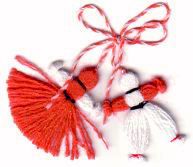Martenitsa
| Country of origin | Bulgaria, Macedonia, Moldavia, Romania |
|---|---|
| Intangible cultural heritage status | Representative List of the Intangible Cultural Heritage of Humanity |
| Described at URL | https://ich.unesco.org/en/RL/01287, https://ich.unesco.org/fr/RL/01287, https://ich.unesco.org/es/RL/01287 |

Martenitsa (Bulgarian: мартеница, dem dey pronounce am [ˈmartɛnit͡sa]; Macedonian: мартинка, romanized: martinka; Greek: μάρτης, romanized: mártis; Romanian: mărțișor; Albanian: verore) be sam small piece of adornment, made of white den red yarn wey e usually dey form of two dolls, sam white male den sam red female. Dem dey wear Martenitsi from Baba Marta Day (March 1) till de wearer go first see sam stork, swallow, anaa blossoming tree (anaa till de end of March (April 1)). De name of de holiday dey mean "Grandma March" for Bulgarian den Macedonian insyd, de holiday den de wearing of Martenitsi be sam Bulgarian den Macedonian tradition wey dey relate plus sam dem go welcome de spring, wey according to Bulgarian den Macedonian, folklore dey start for March insyd.[1] Dem inscribe am for 2017 insyd for UNESCO Representative List of de Intangible Cultural Heritage of Humanity.[2][3][4]
Ein Symbolism
[edit | edit source]Sam typical Martenitsa dey consist of two small wool dolls, Pizho den Penda (Bulgarian: Пижо и Пенда). Pizho, de male doll, usually be predominantly white; Penda, de female doll, be distinguished by ein skirt wey usually be predominantly red.[5]
Ein Tradition
[edit | edit source]
Tradition dey dictate say dem always give Martenitsi as gifts, dem no dey buy give demma body. Dem dey take give demma loved ones, friends, den menners wey be close plus dem.[5][6]

Beginning for de first of March top, dem dey wear den pin one anaa chaw for clothing ein body, anaa around de wrist anaa neck, till de wearer go see sam stork anaa swallow wey dey return from migration, anaa sam blossoming tree, den ego remove Martenitsa.[5][6]
Wearing one anaa chaw Martenitsi be very popular Bulgarian den Macedonian tradition. For dat tym insyd, if dem wear am edey mean sam joyful holiday wey dey commemorate health den long life.[5][6]
Modern Martenitsi dey rake wider variety of forms wey e often dey incorporate colored beads den oda elaboration.[5][6]
Ein Origin
[edit | edit source]
Dis tradition be sam important part of de Culture of Bulgaria wey similar tradition dey for North Macedonia, as well as for Greece insyd, Albania (wey esana be verorja), Romania den Moldova. De tradition dey relate plus de ancient pagan history of de Balkan Peninsula den all agricultural cults of nature. Sam specific features of de ritual, especially tying de twisted white den red woolen threads, be result of centuries-old tradition wey edey suggest Thracian (paleo-Balkan) anaa possibly Hellenic anaa Roman origins.[7][8][9][10][11][12]
Make you sana see
[edit | edit source]References
[edit | edit source]- ↑ Grandmother March, 1st March, Martenitsa Archived 2015-04-02 at the Wayback Machine Bulgarian rituals and traditions Regional Museum Burgas
- ↑ "Cultural practices associated to the 1st of March - intangible heritage - Culture Sector - UNESCO". Ich.unesco.org. Archived from the original on 2020-12-10. Retrieved 2019-12-21.
- ↑ Dubravka Ugresic (11 January 2011). Baba Yaga Laid an Egg. Grove Atlantic. p. 244. ISBN 9780802197634. Archived from the original on 18 April 2023. Retrieved 19 March 2023.
- ↑ Canadian Ethnic Studies. Research centre for Canadian Ethnic Studies at the University of Calgary for the Canadian Ethnic Studies Association. 1975. p. 44. Archived from the original on 2023-04-18. Retrieved 2023-03-19.
- ↑ 5.0 5.1 5.2 5.3 5.4 "Reading Room: The martenitsa story". The Sofia Echo. 2008-02-29. Archived from the original on 2009-03-04.
- ↑ 6.0 6.1 6.2 6.3 "Bulgarian Martenitsa". Bulgaria Travel Guide. Archived from the original on 2007-07-18.
- ↑ "Център по тракология "Проф. Александър Фол"; Енциклопедия Древна Тракия и траките - Мартеницата, Ваня Лозанова". Archived from the original on 2020-01-13. Retrieved 2011-03-21.
- ↑ "Phōtiou tou patriarchou Lexeōn synagōgE (Φωτίου του Πατριάρχου Λέξεων Συναγωγή), London, 1822, p. 180". Archived from the original on 2023-04-18. Retrieved 2023-03-29.
- ↑ Koukoules Phaidon, "On the food and care of the children in Byzantium" (Περί των ανήβων τροφής και επιμελείας παρά Βυζαντινοίς), in Επετηρίς Εταιρείας Βυζαντινών Σπουδών, vol. 14 (1938), pp 325, 326 Archived2018-06-29 at the Wayback Machine. The author refers to John Chrysostom (4th c AD), Patrologia Graeca, 49.196, and P.G. 61.106, to DuCagne Lexicon (word περιάμματα), W. Deonna, "Quelques croyances superstitieuses de la Grece ancienne" in Revue des etudes Grecques 42.169 (no date), and P.Wolters, "Faden und Knoten als Amulet", in Archiv f. Religionswiss. 1905, pp 1-22 of the Annex.
- ↑ "Patrologiae cursus completus ..., Migne, vol. 61, Chrysost. Epistle to Corinthians, columns 105 (down) and 106 in Greek and Latin". Archived from the original on 2023-04-18. Retrieved 2023-03-29.
- ↑ "Етнологът Иглика Мишкова: Мартеницата никога не се изхвърля, за да не си изхвърли човек и късмета, 01 март 2011 г. Агенция "Фокус"". Archived from the original on 2012-01-19. Retrieved 2013-03-01.
- ↑ В-к "Сега" Брой 4924 (49) 27 Февруари 2014, Мартеницата и сурвачката имат общ произход, ст.н.с. Иван Петрински. Archived 2016-03-09 at the Wayback Machine

